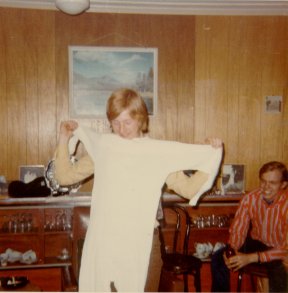Normally I sit down and collect details for this kind of rant, but I’m too enraged to do it right now.
The subject is Microsoft Office and Front Page 2000.
Microsoft has had a monopoly on office “suites” since they intentionally destroyed Word Perfect for Windows by finagling the settings on the links to the operating system so that Word Perfect crashed frequently. Word Perfect never recovered. (Does anyone still remember when Word Perfect had a huge margin on MS Word, in the DOS world?)
Office has a lot of nice functions, a fairly nice interface, and some intriguing capabilities. You can’t avoid using it because almost every office has standardized on it. Employees request it. And it does have some slick features.
But it has a number of very, very large annoyances, all of which serve to profit Microsoft at the users’ expense.
1. What kind of idiot wants to store all his documents in a directory called “my documents”? Well, an idiot. You get a computer. You don’t understand anything about directories or files. You create something in “Word”. Where is it? Where is my document? Oh! Eureka! It’s in “my documents”. How convenient. Convenient, of course, until you have about 200 documents and you need to sort them into logical directories.
And guess what– Microsoft is carrying this absurdity even further! I just noticed there are two new directories on my computer called “my photos” and “my web pages” and “my music”.
And, after reading Bill Gates’ personal web page, I now understand what the meaning is of “my” in those directory names: your files belong to Bill Gates.
2. I have a lot of documents. I store them in many directories. In order to find what I want quickly, I have a list of “favorites”, which narrows down the search considerably, and quickly. Then I installed Front Page 2000 and Internet Explorer. You know what these incomprehensibly stupid programs did? They added my internet bookmarks to my “favorites” list. Does Microsoft honestly think that I now want to keep all my files on web servers all over the globe? And just try to get rid of the extra “favorites” that refer to web sites like “Amazon” (just where I want to store my personal letters, of course). Does anyone know how to get rid of them?
3. I used to create a certain file in Excel and then save it and then import it into Front Page to convert it to a web page so I could adjust the décor, install some images, and fine tune it for my web page. Well, after installing Front Page 2000, whenever I open the file, it opens Excel! Look, you morons, I want to open it in Front Page, not Excel! You can’t even “import” it into Front Page. Are you people incredibly stupid or what?
4. We have an application in the office where I work that runs on Access 95. When we installed Access 97 (as part of Office 97) on our computers, the application could no longer run. So we tried to install Access 95, while leaving the rest of the Office suite alone. Access 95 killed off Access 97. For what reason, pray tell, can you not run both Access 95 and Access 97 on the same computer? Well, the obvious reason is Microsoft’s desire to bully you into upgrading everyone in your office to Office 97.
5. For that same application, we needed some kind of module from the Developer’s Tool Kit for Office 95, which cost about $1000. We bought it. We installed it. Then we found out the application will not work with Office 97. So we went looking for the Developer’s Toolkit for Office 97. Microsoft didn’t offer it anymore. Tell you what though– if you upgrade everyone in the office to Office 2000, you can buy some other combination of stupid modules for $2000 that might give you the same functionality. But then again, it might not. Nobody knows for sure. And just think: right at this very moment, Microsoft is probably hatching their next evil plan to make your life miserable until you buy some new, expensive Microsoft application, which only make your life even more miserable.
6. I invest a lot of work in templates. They save a lot of time, if you create web pages that essentially require similar formats and images. So where are the templates for Front Page? Where are they hiding? In a directory called “templates”? Damned if I know. Where are the Office 2000 templates now? Here’s a history of where templates used to go:
- Word 6.0 c:\msoffice\msword\templates
- Office 95 c:\msoffice\templates
- Office 97a c:\program files\msoffice\templates
- Office 97b c:\program files\Microsoft\office\templates
- Office 2000 c:\program files\Microsoft\office\templates\??????
When I tried to find my Front Page templates, I ended up in a directory called:
..\..\..\windows\application data\Microsoft\chromehorse\images\rotw.jpg
Now the “chromehorse” and “rotw.jpg” are mine. They belong in c:\chromehorse. What is this file doing here? Why is Microsoft continually hiding stuff all over the place on my humungous hard drive, so it is almost impossible to figure out what files belong where and what they do? Well, it’s not some weird sort of complex system of preserving your data. In fact, this ‘system’ is designed to embed defaults into Windows that make you wholly and utterly dependent on the operating system (Microsoft) to manage your data. And the aim of all of this is to make it less and less conceivable or possible for you to use any product that doesn’t understand these secrets intimately. In other words, any product other than those made by Microsoft.
7. Do you use the power save functions of Windows? Then your system has probably crashed. It probably went into power save mode and wouldn’t “wake up”. It went into a coma. And guess what? If you shut off the power switch on the back of your computer so you can reboot, you might very well lock the system into a permanent coma. You might have to pull the battery off the motherboard to get it to wake up again. If they can’t make the power save functions work properly, why do they even bother to put them in?
8. Wow. Even as I was writing this, I discovered a new incredibly irritating “feature”. In order to get around the other idiotic defaults of Office 2000, I decided to import my favorite Front Page template into Word and save it as a Word template. Then I can use it to write my rants in Word and save them in HTML for transfer to my web page. But guess what? When I try to import the template, Office opens Front Page instead of Word, even when I try to open the document in Word!
Whoa nelly! I just found out where Microsoft is really storing my Office templates! It’s in:
c:\windows\application data\Microsoft\templates
So we can add this to the list.
And you can think about how efficient it is to keep moving your files around like that. It’s as if every six months, your company moved their head office to a different building in a different town, and hid all the office supplies in various new locations, and changed all your user names and passwords, and won’t tell you where the parking garage is.
Wow.
As for my templates….
I’m not sure where my templates are actually. There are some bizarre file names at the tail end of that directory, none of which tell me where my laboriously designed and crafted templates are.
So, never forget that Microsoft’s goal is to put a computer into every trailer in every trailer park in America. Never forget that customers can be broken down into three categories.
10% all smart people
44% all educated people and smart people
90% people who live in trailer parks and smart people and educated people
And Microsoft probably understands that 90% very well.
“Honey, where the hell are my documents?”
“You don’t have any documents, dear. You are illiterate.”
“Oh yeah. I forgot.”
By the way, Microsoft isn’t the only evil empire out there. Netscape stores your precious e-mails and bookmarks in a directory called:
c:\program files\communicator\users\mail
And your e-mail files are huge. Why? I don’t know. What are they storing in there? One of my email files is about 80 megabytes and contains about 500 messages. What on earth are they storing in there? Every address of every web page on the face of the earth in every message? Details of the merger with Warner Brothers?
Folks, it’s like TV. When TV started, in the 1950’s, we had some first-rate plays and dramas sponsored by Hallmark and other corporations looking for prestige.
Within ten years, we had “The Beverly Hillbillies”, “Green Acres”, “Mr. Ed”, “Petticoat Junction”, and “Gomer Pyle”.








